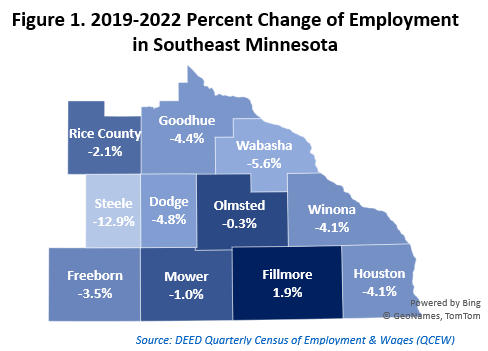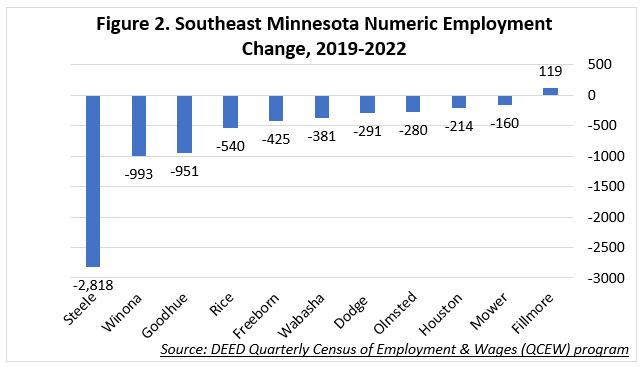by Amanda O'Connell
August 2023
As a region, Southeast Minnesota has seen a relatively strong recovery from the Pandemic Recession. But encompassing 11 counties, the Southeast planning region's widespread trends fail to align with specific county-level experiences, some of which are positive, while others have been more severely impacted.
This Spotlight article aims to provide a review of recent employment patterns at the county level, equipping locals with insights to assess their county's performance over the last three years. This article will explore and compare annual average employment data from the Quarterly Census of Employment & Wages for 2019 to 2022. In addition, data from DEED's Location Quotient Tool will be utilized to measure employment concentration in the region and counties to compare to the state.
In 2022 Southeast Minnesota had 13,373 establishments, providing 239,872 jobs. Since 2019 Southeast Minnesota has experienced a decline of 6,936 jobs, a drop of 2.8%. However, Southeast added 729 more reporting firms since 2019, a 5.8% increase. The largest percent change in firms was in the Health Care and Social Assistance sector, which gained 366 firms, a 24% increase. Only three sectors saw a net loss in firms from 2019 to 2022 in Southeast Minnesota. These include Manufacturing (13 or 1.9%), Retail Trade (86 or 5.1%), and Wholesale Trade (5 or 1%).
On the employment side, Southeast Minnesota experienced the largest increase of jobs in Management of Companies1 (1,380 or 47.8%), Professional and Technical Services (271 or 8%), and Transportation and Warehousing (150 or 1.9%). Southeast Minnesota had higher employment concentrations in Agriculture, Forestry, Fishing, and Hunting (LQ of 1.7), Health Care and Social Assistance (LQ of 1.6), Manufacturing (LQ of 1.6), Utilities (LQ of 1.2), and Retail Trade (LQ of 1.1).
Fillmore County was the only county in the region to add jobs (119 or 1.9%) from 2019 to 2022. Olmsted and Mower are also nearly back to their pre-pandemic employment levels. All other counties in the region experienced job losses that have not been recovered, with Steele County experiencing the largest decrease in jobs (2,818 or 12.9%), with Wabasha and Dodge also seeing more severe and longer-lasting declines (see Figure 1 and Figure 2).


Dodge County was home to 5,755 jobs in 2022, down 291 jobs (4.8%) since 2019. The largest numeric decrease in jobs was in the Manufacturing sector, which lost -208 jobs from 2019 to 2022. Additional losses were in Accommodation and Food Services (48 or 12.2%), Public Administration (38 or 9.5%), and Transportation and Warehousing (26 or 12.3%). The industries that gained jobs during this time include Construction (40 or 7.8%), Other Services (19 or 13.8%), Wholesale Trade (16 or 2.3%), and Arts, Entertainment, and Recreation (16 or 22.9%). Dodge County has higher employment in the Construction sector and Wholesale Trade compared to the state of Minnesota, with Location Quotients (LQ) of 1.9 and 2.6, respectively.
Fillmore County was the only county to experience an increase in jobs from 2019 to 2022. Across all industries, the number of jobs increased by 119 or 1.9%. The overall growth was fueled by the Transportation and Warehousing sector, which gained 50 jobs, an increase of 25.5%. Smaller gains were found in Construction (33 or 12.2%) and Professional and Technical Services (30 or 29.1%). In addition, Fillmore County had the largest percent change in number of firms within this time period. In 2019 Fillmore County had 691 firms; in 2022, they had 767, an increase of 76 firms or +11%. Fillmore County has a higher concentration of employment in the Utilities sector (LQ of 2.4) and Public Administration (LQ of 1.8).
Freeborn County provided 11,663 jobs in 2022, which was down by 425 jobs since 2019. However, Freeborn County experienced an increase in firms by adding 16, or 2% since 2019 as more establishments started reporting in. Health Care and Social Assistance saw the most significant decline in jobs during the Pandemic Recession and recovery, recording a drop of 19.8%. Manufacturing saw a loss of 116 jobs or a decrease of 4.6%. In contrast Retail Trade (199 or 11.2%), Transportation and Warehousing (64 or 12.5%), and Construction (46 or 9.7%) saw an increase in jobs from 2019 to 2022. \ Freeborn County has more employment in Retail Trade compared to the state of Minnesota, with a location quotient of 1.7.
Goodhue County had the third largest numeric decrease in jobs, a drop of 951 jobs or 4.4%. The largest sector to see a reduction was Arts, Entertainment, and Recreation, with a decrease of 250 jobs or 16.3%. Similar findings are found at the state level from the strain the COVID-19 Pandemic put on this sector, such as venue closures, social distancing measures, and travel restrictions. There was also a decrease in jobs in the Health Care and Social Assistance (249 jobs or 8%), Transportation and Warehousing (123 or 18.4%), and Construction (108 or 12.1%) sectors. However, there were increases in Wholesale Trade (64 or 9.0%) and Educational Services (59 or 4.4%). Goodhue County has one of the highest employment concentrations in the Utilities sector in the state with a location quotient of 7.7.
Houston County experienced an overall decrease of 214 jobs or 4.1% from 2019 to 2022. The sectors with the most significant decreases were found in Manufacturing (59 or 10.7%), Accommodation and Food Services (38 or 11.9%), and Wholesale Trade (28 or 30.8%). Sectors that gained jobs include Retail Trade (22 or 4.7%), Real Estate and Rental and Leasing (19 or 111.8%), and Administrative Support and Waste Management Services (17 or 15.9%). A unique characteristic of Houston County is that it has a higher concentration of employment in the Information (LQ of 1.8), Public Administration (LQ of 1.9), Other Services (LQ of 1.3), Transportation and Warehousing (LQ of 2.2), and Agriculture, Forestry, Fishing, and Hunting (LQ of 3.6) sectors compared to the state of Minnesota.
Mower County experienced a reduction of 160 jobs or 1% from 2019 to 2022. Among the 11 counties Mower County ranks second lowest in numeric job losses in this period. The largest deficits were found in the Health Care and Social Assistance sector (272 jobs or 9.6%), Other Services (146 or 26.9%), and Public Administration (106 or 13.3%). But employers in the county added jobs in Educational Services (122 or 7.8%), Arts, Entertainment, and Recreation (96 or 61.1%), and Retail Trade (55 or 3.3%). With a location quotient higher than 1, Mower County has a higher concentration of employment in Manufacturing (LQ of 1.9), Educational Services (LQ of 1.3), and Retail Trade (LQ of 1.1) compared to the state.
Olmsted County provided the most jobs of the 11 counties in the Southeast region in 2022 with 100,445 jobs, a slight decrease of-280 jobs or 0.3% since 2019. Olmsted ranks second in percentage change in job losses in this period, nearly recovering all jobs lost in 2020. The sectors that took the biggest hit include Manufacturing (998 jobs or 14.3%), Accommodation and Food Services (535 or 6.4%), and Information (344 or 26.5%). Some sectors in Olmsted County gained jobs from 2019 to 2022, such as Administrative Support and Waste Management Services (913 or 30.8%), Health Care and Social Assistance (631 or 1.4%), and Professional and Technical Services (223 or 15.5%). Olmsted County had the largest numeric change in the number of firms in the Southeast region as well, adding 256 firms, a 6.9% increase since 2019. Home to Rochester, Olmsted County had more concentrated employment in the Health Care and Social Assistance sector with a location quotient of 2.7.
Rice County provided the second most jobs of the 11 counties in the Southeast region in 2022 with 25,041 jobs despite a decrease of 540 jobs or 2.1% since 2019. The sectors with the largest numeric declines in jobs in this time period include Health Care and Social Assistance (379 or 11.8%), Information (79 or 31.0%), and Construction (65 or 5.7%). Sectors such as Manufacturing (48 or 1.0%), Utilities (34 or 76.9%), and Administrative Support and Waste Management Services (32 or 5.3%) gained jobs from 2019 to 2022. Rice County had a location quotient of 2.0 in the Educational Services sector and a location quotient of 2.8 in Agriculture, Forestry, Fishing, and Hunting, meaning there was a higher employment concentration in these sectors compared to the state of Minnesota.
Steele County had far and away the largest numeric and most severe percentage decline in jobs from 2019 to 2022, with a loss of 2,818 jobs or 12.9%. The largest decreases were found in Administrative Support and Waste Management Services, which lost 1,594 jobs, a drop of 69.5%. In addition, Finance and Insurance (1,484 or 83.5%) and Manufacturing (756 or 13.4%) had a decrease in the number of jobs from 2019 to 2022. However, Steele County had the third highest numeric change in firms and percent change in firms by adding 85 firms since 2019. There is a significant presence of employment in the Manufacturing and Retail Trade in Steele County, compared to Minnesota, with location quotients of 2.3 and 1.5, respectively.
Wabasha County lost 381 jobs, a drop of-5.6% from 2019 to 2022. Manufacturing took the largest hit in jobs with a decrease of 254 jobs or 15.7%, followed by Accommodation and Food Services with a decline of 42 jobs or 7.5%. Job gains were found in Professional and Technical Services with 21 jobs or 24.8%. Wabasha County had a location quotient of 1.1 in the Arts, Entertainment, and Recreation sector in 2022, meaning it had above average employment compared to Minnesota.
Winona County provided 23,524 jobs in 2022, the third most in the 11-county Southeast region. Winona County lost the second most jobs from 2019 to 2022 by losing 993 jobs, a drop of 4.1%. Sectors that declined the most include Manufacturing (273 or 4.7%), Educational Services (210 or 6.6%), and Administrative Support and Waste Management Services (162 or 25.2%). Job gains were found in the Transportation and Warehousing sector, with an increase of 103 jobs or 8.3%, and Other Services with a gain of 43 jobs or 8.6% increase. Winona County has a higher employment concentration in four sectors compared to the state: including Manufacturing (LQ of 2.1), Educational Services (LQ of 1.6), Transportation and Warehousing (LQ of 1.4), and Retail Trade (LQ of 1.1).
All 11 counties are working their way toward full recovery with varying results so far. With specializations in different industries and challenges with labor force availability, each county has its own unique challenges in regaining or adding new employment. Moving forward, Southeast Minnesota will need to continue working to align job seekers with job vacancies to maximize the strengths of the region and continue growing.
1This increase in employment was due to an industry code correction based on a non-economic code change.